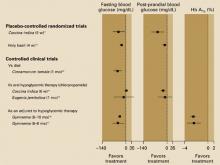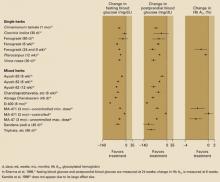Gymnema sylvestre. Baskaran, Ahamath, Shanmugasundaram, et al (1990) studied the effects of GS4, a specific isolate of G sylvestre, on the blood sugar of 47 type 2 diabetes patients.16 The intervention group consisted of 22 patients with diabetes on oral hypoglycemic therapy (continued during the trial), plus herbal therapy with Gymnema at a dose of 400 mg/d. The control group consisted of 25 patients with type 2 diabetes on conventional medications alone. Although the arms were reasonably matched for age and Broca index (percent of ideal body weight) based on our analysis of individual patient data in the study, the 2 arms were statistically different at baseline with respect to fasting blood sugar. The authors reported that in the intervention group at 12 months of follow-up, mean fasting blood sugar improved from 174 mg/dL to 124 mg/dL (P<.001) and Hb A1c improved from 11.9% to 8.48% (P<.001). Changes in the control group over this time were not significant. Virtually all patients in arm I developed hypoglycemic symptoms, and the dose of their normal oral hypoglycemic agent needed to be changed or stopped. The Jadad score is 0. This study was identified from the Western literature search.
GS4. Shanmugasundaram, Rajeswari, Baskaran, et al (1990b) reported the effect of an herbal compound GS4 on blood glucose, insulin requirements, and cholesterol in patients with type 1 and type 2 diabetes.17 The intervention group consisted of 23 type 1 patients and 4 type 2 patients (ages 44–50 years, 25% female) who continued their insulin in addition to taking the herbal intervention, and the control group consisted of 37 type 1 patients who were on insulin therapy. The clinical equivalence of the 2 arms at baseline was not mentioned. The intervention drug was GS4, a recrystallized precipitate of the alcoholic extract of the acidic fraction of G sylvestre; at dose of 400 mg/d. At 6 to 8 months of follow-up, all patients in the intervention group developed hypoglycemic episodes, and their insulin doses were reduced by 10 units at a time; differences compared to controls were statistically significant. The Jadad score was 1. This study was identified from the Western literature search.
Summary. In summary, comparisons of the studied herbs with either placebo, diet, or as an adjunct to medical hypoglycemic therapy consistently reported statistically significant benefits in glucose control. Studies comparing herbs to the oral hypoglycemic chlorpropamide did not report differences between groups.
FIGURE 2
Glucose-lowering effects of Ayurvedic herbs compared with nonherbal treatments
Case series or cohort studies without a concurrent comparison group
Fifteen studies had treatment arms that reported blood glucose or Hb A1c values before and after herbal interventions—ie, that made available pre/post data.13,18-31 Herbs were tested singly (7 studies), in combination (7 studies), or both singly and in combination (1 study). All of these studies are limited by the lack of randomization. Many are also limited by small sample size and short study duration.
The data are presented in FIGURE 3 in the following order: studies or arms of studies using a single herbal preparation first, followed by studies that use a formula or a group of herbs and minerals. Some studies with multiple arms will have listings in more than one place. As FIGURE 3 shows, most pre/post comparison studies using single herbs and formulas favor treatment. Hb A1c is measured in only 5 of the studies. Two of those studies seem to strongly favor treatment; 2 are almost equivocal; and 1 does not favor treatment.
The small number of RCTs/CCTs/natural experiments measuring postprandial blood glucose and Hb A1c, and the small number of case series and cohorts measuring Hb A1c, make the assessment of publication bias for these outcomes problematic. For the remaining outcomes, only slight evidence of publication bias was evident among the case series and cohort studies for the fasting blood glucose outcome (adjusted rank correlation test P=.97; regression asymmetry test P=.06). For this outcome, we have trial data available, a setting in which no evidence of publication bias is seen.
FIGURE 3
Effect of Ayurvedic herbs on blood glucose and Hb A1c
Discussion
No controlled trials have assessed Ayurveda as a system of care. Furthermore, among studies of herbal preparations, controlled trials are rare and mostly of poor quality. Still, we found evidence suggesting that some Ayurvedic herbs have clinically important hypoglycemic effects.
The best-quality RCT reported beneficial results for C indica. Other studies have generally reported benefits of C indica; however, results have been inconsistent.



